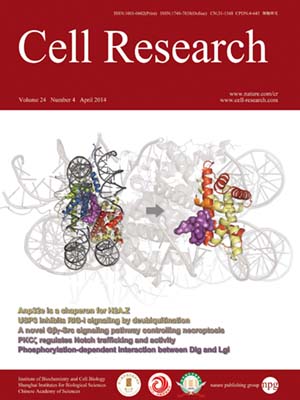
Volume 24, No 4, Apr 2014
ISSN: 1001-0602
EISSN: 1748-7838 2018
impact factor 17.848*
(Clarivate Analytics, 2019)
Volume 24 Issue 4, April 2014: 464-481
ORIGINAL ARTICLES
Species-dependent neuropathology in transgenic SOD1 pigs
Huaqiang Yang1,#, Guohao Wang2,#, Haitao Sun3,#, Runzhe Shu4,#, Tao Liu1, Chuan-En Wang5, Zhaoming Liu1, Yu Zhao1, Bentian Zhao1, Zhen Ouyang1, Dongshan Yang1, Jiao Huang1, Yueling Zhou3, Shihua Li5, Xiaodan Jiang3, Zhicheng Xiao3,4,6, Xiao-Jiang Li2,5 and Liangxue Lai1
1Key Laboratory of Regenerative Biology, South China Institute for Stem Cell Biology and Regenerative Medicine, Guangzhou Institutes of Biomedicine and Health, Chinese Academy of Sciences, Guangzhou, Guangdong 510530, China
2State Key Laboratory of Molecular Developmental Biology, Institute of Genetics and Developmental Biology, Chinese Academy of Sciences, Beijing 100101, China
3Department of Neurosurgery, The National Key Clinic Specialty, The Neurosurgery Institute of Guangdong Province, Guangdong Provincial Key Laboratory on Brain Function Repair and Regeneration, Zhujiang Hospital, Southern Medical University, Guangzhou, Guangdong 510280, China
4Department of Anatomy and Developmental Biology, Monash University, Clayton, Victoria 3800, Australia
5Department of Human Genetics, Emory University School of Medicine, Atlanta, GA 30322, USA
6The Key Laboratory of Stem Cell and Regenerative Medicine, Institute of Molecular and Clinical Medicine, Kunming Medical University, Kunming, Yunnan 650500, China
Correspondence: Xiao-Jiang Li, E-mail: xli2@emory.edu; Xiaodan Jiang, E-mail: Jiangxiao_dan@163.com; Zhicheng Xiao, E-mail: zhicheng.xiao@monash.edu; Liangxue Lai,(lai_liangxue@gibh.ac.cn)
Mutations in the human copper/zinc superoxide dismutase 1 (hSOD1) gene cause familial amyotrophic lateral sclerosis (ALS). It remains unknown whether large animal models of ALS mimic more pathological events seen in ALS patients via novel mechanisms. Here, we report the generation of transgenic pigs expressing mutant G93A hSOD1 and showing hind limb motor defects, which are germline transmissible, and motor neuron degeneration in dose- and age-dependent manners. Importantly, in the early disease stage, mutant hSOD1 did not form cytoplasmic inclusions, but showed nuclear accumulation and ubiquitinated nuclear aggregates, as seen in some ALS patient brains, but not in transgenic ALS mouse models. Our findings revealed that SOD1 binds PCBP1, a nuclear poly(rC) binding protein, in pig brain, but not in mouse brain, suggesting that the SOD1-PCBP1 interaction accounts for nuclear SOD1 accumulation and that species-specific targets are key to ALS pathology in large mammals and in humans.
10.1038/cr.2014.25
FULL TEXT | PDF
Browse 2266


